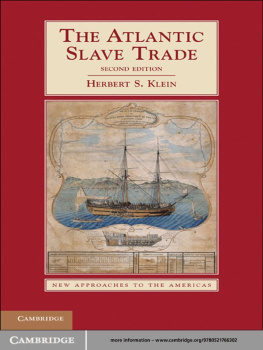Contents

RECAPTURED AFRICANS
This book was published with the assistance of the John Hope Franklin Fund of the University of North Carolina Press.
2017 The University of North Carolina Press. All rights reserved.
Designed and set in Merlo by Rebecca Evans.
Manufactured in the United States of America The University of North Carolina Press has been a member of the Green Press Initiative since 2003.
Cover image: Recaptive boys of the slave ship Zeldina in Jamaica.
Illustrated London News engraving, 20 June 1857.
Courtesy of the Huntington Library, San Marino, California.
Yvette Christians, When All Else Fails and What the Girl Who Was a Cabin Boy Heard or SaidWhich Is Not Clear, from Yvette Christians, Castaway, 63 and 56.
1999, Duke University Press. All rights reserved. Republished by permission of the copyright holder. www.dukeupress.edu.
Children Crying, by The Congos, from Heart of the Congos. Reprinted by permission of the copyright holder. VP Records.
Portions of Chapters 3 and 5 appeared previously in somewhat different form in Sharla M. Fett, Middle Passages and Forced Migrations: Liberated Africans in Nineteenth-Century U.S. Camps and Ships, Slavery and Abolition 31, no. 1 (2010): 7598. Reprinted by permission of www.tandfonline.com.
Portions of Chapter 4 appeared previously in somewhat different form in Sharla M. Fett, The Ship of Slavery: Atlantic Slave Trade Suppression, Liberated Africans, and Black Abolition Politics in Antebellum New York, in Paths of the Atlantic Slave Trade: Interactions, Identities, andImages, ed. Ana Lucia Araujo (New York: Cambria, 2011), 13160. Reprinted with permission.
Library of Congress Cataloging-in-Publication Data
Names: Fett, Sharla M., author.
Title: Recaptured Africans : surviving slave ships, detention, and dislocation in the final years of the slave trade / by Sharla M. Fett.
Description: Chapel Hill : The University of North Carolina Press, [2016] | Includes bibliographical references and index.
Identifiers: LCCN 2016024828| ISBN 9781469630021 (cloth : alk. paper) | ISBN 9781469630038 (ebook)
Subjects: LCSH : SlavesUnited StatesSocial conditions19th century. | SlavesUnited StatesHistory19th century. | Slave tradeUnited StatesHistory19th century.
Classification: LCC E453.F48 2016 | DDC 306.3/620973dc23 LC record available at https://lccn.loc.gov/2016024828
TO ELLA & JACOB
A better and more beautiful world
from Chronicles of the Hull
WHEN ALL ELSE FAILS
And now, be kind
stars, gods, be kind
whatever names you go by
in our many prayers
and thanksgivings
be kind
when our fingers break
against the wood that
holds us
be kind
when we hear our voices
fall flat out of the
childhood we lose
be kind
in the darkness,
be kind
when they wash us
heavily and feed us
with rough concessions
be kind
to our yesterdays, our
back theres, the generations
we shed as we squat
in place among strangers.
To our hands, be kind,
To our ankles, our eyes
be kind
to our memories
even
our forgetting.
Yvette Christians, Castaway
CONTENTS
FIGURES & MAP
Figures
1.1 Title page from Captain Canot
2.1 Steamboat excursion advertisement
2.2 Charleston Mercury advertisement
3.1 The Princess Madia, engraving
3.2 Sketch of 1860 Key West African Depot
3.3 Recaptive boys, Zeldina, 1857
3.4 Zeldina recaptives at Fort Augusta, Jamaica, 1857
3.5 William shipmates disembarking at Key West
3.6 The Barracoon at Key West, engraving
3.7 The Africans of the Slave Bark Wildfire, engraving
3.8 An African, engraving
3.9 The Only Baby among the Africans, engraving
4.1 James W. C. Pennington portrait
5.1 William Proby Young self-portrait
5.2 Castilian recaptive shipmates roster, by age and gender
6.1 American Colonization Society map of Liberia, West Africa
6.2 Congo Town near Mesurado River in Liberia, map detail
Map
Atlantic Routes of Echo, Wildfire, William, and Bogota Recaptive Shipmates
TABLES
1 Dual Voyages of Recaptive Shipmates in U.S. Custody, 1858 and 1860
2 Recaptive Death and Survival in Circuits of Slave Trade Suppression, 1858 and 1860
3 Percentage Mortality on Slave Ships, in U.S. Camps, and on Transport Ships to Liberia
4 Daily Mortality Rates by Phase of Voyages
5 Recaptive Arrivals in Liberia, 18581861
ACKNOWLEDGMENTS
This book has been long in the making. I could never have written it without the insight and support of many colleagues, friends, and family members. Many years ago at the Virginia Historical Society, Lee Shepard and Frances Pollard introduced me to the history of recaptive journeys by suggesting that I look at William Proby Youngs ship log. The Ralph J. Bunche Center for African American Studies at UCLA provided an incubating space in which to begin thinking about how to tell the story of West Central African youth in the immediate wake of slave ship captivity. As the project picked up speed, a critical long-term Mellon Fellowship at the Huntington Library afforded the luxury of a years research in a rich intellectual climate. I am also indebted to Occidental Colleges faculty sabbatical program and the Faculty Enrichment Grants that enabled research, travel, and precious time to think and write. My thanks as well to the many archivists and librarians who answered my queries at the South Carolina Historical Society, the South Caroliniana Library, the American Antiquarian Society, the West Virginia and Regional History Center, the Monroe County Public Library in Key West, and the National Archives and Records Administration. Thanks to Brooke Guthrie at Duke Universitys David M. Rubenstein Rare Book and Manuscript Library for her quick response to a key archival finding.
On my long and humbling journey to becoming an Atlantic historian, I learned from many generous colleagues. My fellow Occidental College historians Jem Axelrod, Sasha Day, Lynn Dumenil, Michael Gasper, Nina Gelbart, Jane Hong, Maryanne Horowitz, Paul Nam, Alexandra Puerto, Lisa Sousa, and Marla Stone have been a front line of support, offering insights from their own fields of research. Carol Siu and John De La Fontaine went the extra mile to assist with interlibrary loans and database access. From my year at the Huntington Library, Im grateful for conversations with Nancy Bercaw, Roy Ritchie, LeeAnn Whites, and especially Kevin Dawson, who generously shared sources and insights in subsequent years. Ariela Gross and Judith Jackson Fossett hosted an interdisciplinary slavery studies working group at the University of Southern California that introduced me to profound scholarship on issues of legacy and redress. Elsa Barkley Brown, Adam Rothman, and Jessica Marie Johnson, along with other participants in the African American Political Culture Workshop at the University of Maryland, College Park, offered just the right critiques at a key point in my thinking about Atlantic child trafficking and recaptivity. Sandra Gunning and participants in the Neoslaveries in the Nineteenth-Century Atlantic World Symposium at the University of Michigan helped me to think comparatively about the eras many forced migrations. Im grateful to Carla Pestana, Robin Derby, and Andrew Apter for involving me in the UCLA Atlantic History Speaker Series and to Alex Borucki for opportunities to share work with UC Irvines History Department and Medical Humanities Initiative. Corey Malcom, director of archaeology at the Mel Fisher Maritime Museum, took time to give me a historical tour of Key West and shared his own extensive research on recaptives of the







